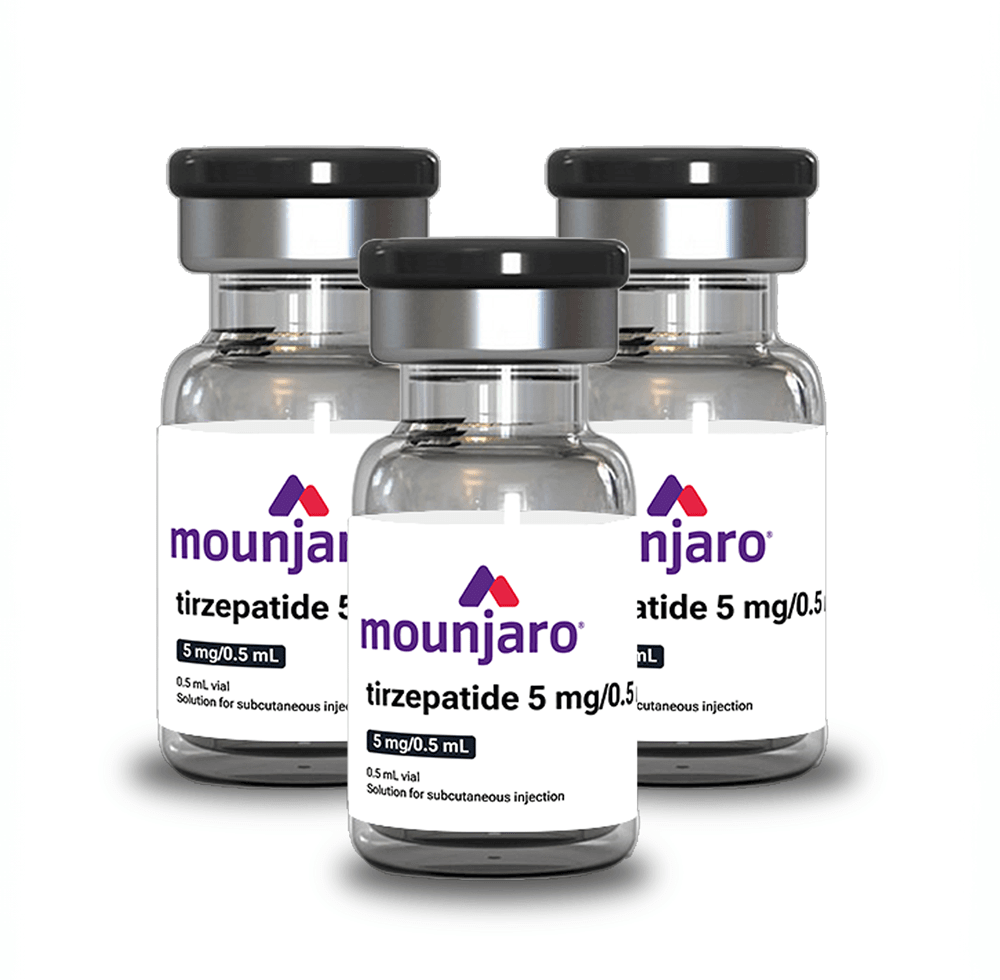Mounjaro (generic name: tirzepatide) is an injectable prescription medicine that is used to treat adults with type 2 diabetes. It is prescribed along with diet and exercise to improve control of blood sugar levels. Mounjaro is widely used thanks to its efficacy and safety as a single therapy or with other diabetes medicines.
Tirzepatide (GIP/GLP-1 RA) is a single molecule combining glucose-dependent insulinotropic polypeptide (GIP) and glucagon-like peptide-1 receptor agonist (GLP-1RA). It activates the secretion of GIP and GLP-1 receptors from the intestines on ingestion of glucose or nutrients, which in turn stimulates insulin secretion from pancreatic β cells. It also is
active in regions of the brain that regulate food intake. Tirzepatide slows down the emptying of the stomach after eating, leaving people feeling full for longer and suppressing appetite.
While there is no cure for diabetes, it was found in studies of Mounjaro that after 52 weeks, when administered both with or without other diabetes medications, 75% to 90% of patients with an average starting HbA1C of 7.9% to 8.6% reached an HbA1C of less than 7%.
Mounjaro is also effective to induce weight reduction and its sister drug
Zepbound was approved by the FDA for weight loss in November 2023. In studies, weight loss in adults ranged from 12 lb (5 kg) to 25 lb (10 kg). The results in trials where candidates received tirzepatide surpassed the weight lost in trials of other GLP-1 agonists.
Mounjaro can only be prescribed
off-label for patients classified as overweight (Body Mass Index between 27 and 30) with at least one weight-related comorbid condition, such as dyslipidemia, hypertension, obstructive sleep apnea, or cardiovascular disease) or obese (BMI 30 or higher).
Mounjaro is not for use in people with type 1 diabetes.
Dosage
Mounjaro comes in single-dose vials with syringes for subcutaneous injection, or a Kwikpen contain 4 doses. It should be administered once each week on the same day of the week and at approximately the same time of day. It must injected in rotation in either the abdomen, thigh, or upper arm by choosing a different site each week.
If a dose is missed, it can be made up for within three days, but beyond that, the dose must be skipped and the routine dose taken on the due date. Do not take two doses of Mounjaro within 72 hours of each other and if it is necessary to change the day, make sure there are at least 72 hours in between doses.
If taking insulin and Mounjaro simultaneously, do not inject them close together in the same area.
Carefully read the information and follow instructions on the manufacturer Eli Lilly and Company’s Product Insert leaflet that comes with the medication to ensure safe usage. Watch a step-by-step video on how to use Mounjaro. We cannot be held liable for any harm caused by incorrect usage.
Storage
Store Mounjaro in the refrigerator (2–8°C/36-48°F). Do not freeze and if one has been frozen, do not use it. Store the pens and vials in their original packaging in order to protect them from light.
Mounjaro can be kept unrefrigerated, but not above 30ºC (86°F), for up to 21 days. If the medicine has been left out of the refrigerator for more than 21 days, it must be discarded, even if the expiry date has not yet been reached.
Common Questions About Mounjaro
Can I travel with Mounjaro pens?
If traveling, Mounjaro pens in their original carton can be kept for up to 21 days outside of the refrigerator as long as the temperature doesn’t go higher than 86°F (30°C).
Who should not take Mounjaro?
Doctors usually do not prescribe Mounjaro to:
- People with a history of medullary thyroid cancer (MTC) or multiple endocrine neoplasia syndrome type 2 (MEN 2)
- Those with a history of severe pancreatitis
- Pregnant or breastfeeding women (safety data is limited)
Can Mounjaro be taken with other diabetes medications?
Yes, but it depends on the specific medications. Mounjaro is often used alongside metformin or other diabetes drugs, but adjustments may be needed to avoid side effects like low blood sugar (hypoglycemia).
Does Mounjaro cause low blood sugar (hypoglycemia)?
Mounjaro alone has a low risk of causing hypoglycemia. However, when combined with other diabetes medications like insulin or sulfonylureas, the risk increases. Doctors may adjust doses to prevent low blood sugar episodes.
This text is for informational purposes only. Please consult a doctor or pharmacist before using any medication.
Read the information leaflet that comes with the medication.
If a sudden allergic reaction (anaphylaxis) occurs after taking Mounjaro, with symptoms like swelling of the face, tongue, or throat making it difficult to breathe or swallow, or there is wheezing, hives, rash, blistering, or peeling of the skin, call a doctor or 911 right away, or go to an emergency room immediately.
Most people who use Mounjarodo not experience any adverse side effects. Doctors prescribe this medication because they assess the benefits of such treatment outweigh any likely unwanted effects.
Some of the side effects that have been reported are:
- Nausea
- Diarrhea
- Decreased appetite
- Vomiting
- Constipation
- Indigestion
- Stomach pain.
If these persist or worsen, consult with a healthcare provider.
Most nausea, vomiting, and diarrhea events occurred while the dose of Mounjaro was being increased and this decreased over time.
Please note that not all possible side effects can be listed. If any of these or other unexpected side effects are experienced, seek medical attention promptly.
Cautions
For people who have kidney problems, side effects like diarrhea, nausea, and vomiting may cause a loss of fluids (dehydration), which may cause kidney problems to get worse. It is important to drink fluids to help reduce any chance of dehydration.
Gallbladder problems have been reported by some people using Mounjaro. Tell a healthcare provider right away if symptoms of gallbladder problems appear, which may include pain in the upper abdomen, fever, yellowing of skin or eyes (jaundice), and clay-colored stools.
Mounjaro may cause tumors in the thyroid, including thyroid cancer. Watch for possible symptoms, such as a lump or swelling in the neck, hoarseness, trouble swallowing, or shortness of breath. If you have any of these symptoms, tell your healthcare provider.
- Do not use Mounjaro if you or any member of your family have ever had a type of thyroid cancer called medullary thyroid carcinoma (MTC).
- Do not use Mounjaro if you have Multiple Endocrine Neoplasia syndrome type 2 (MEN 2).
- Do not use Mounjaro if you are allergic to it or any of the ingredients in Mounjaro.
Mounjaro may cause serious side effects, including:
- Inflammation of the pancreas (pancreatitis). Stop using Mounjaro and call your healthcare provider right away if you have severe pain in your stomach area (abdomen) that will not go away, with or without vomiting. You may feel the pain from your abdomen to your back.
- Low blood sugar (hypoglycemia). Your risk for getting low blood sugar may be higher if you use Mounjaro with another medicine that can cause low blood sugar, such as a sulfonylurea or insulin. Signs and symptoms of low blood sugar may include dizziness or light-headedness, sweating, confusion or drowsiness, headache, blurred vision, slurred speech, shakiness, fast heartbeat, anxiety, irritability, or mood changes, hunger, weakness and feeling jittery.
- Changes in vision. Tell your healthcare provider if you have changes in vision during treatment with Mounjaro.
Mounjaro (tirzepatide, combining GIP and GLP-1 receptor agonists) treats adults with type 2 diabetes. It has not yet been approved for children under the age of 16.
The drug can lower blood sugar levels, but is not a cure for diabetes. Do not stop taking Mounjaro without consulting with a doctor.
Tirzepatide, under the brand name Zepbound, can also be prescribed for patients who are overweight with ancilliary problems such as dyslipidemia, hypertension, obstructive sleep apnea, or cardiovascular disease, and for people who are obese (BMI higher than 30).














